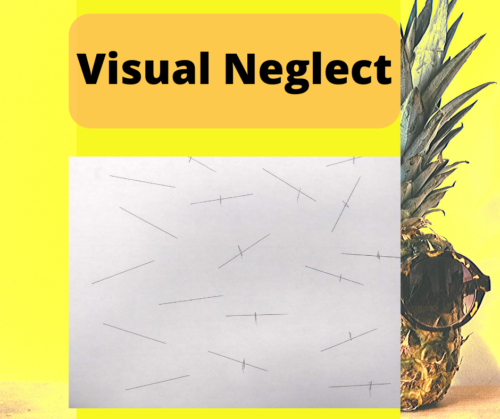Visual neglect is a neuropsychological condition where patients lose awareness of sensory information from their visual field on one side (typically left). This may occur with or without accompanying visual field loss on the same side. This type of deficit usually results from a stroke or an injury to the temporal parietal area of the brain. For patients with visual field loss, they are aware that objects exist in their field loss although they may still make errors and frequently miss the object. For those with neglect, the awareness of that side of the field does not exist.
Visual neglect is a category of broader based hemispatial neglect that can lead to both sensory and motor deficits. For patients with motor neglect, they may not use a limb even though they possess the neuromuscular ability to do so.
Testing for Neglect
A Line Cancellation Test is one of many that can test for neglect. The patient marks the center of the lines shown on the paper. The example above is from a stroke patient with visual neglect who failed to acknowledge that the left side of the page existed.
Finishing food on only one side of the plate or grooming on one side of the face are some real-life examples of neglect. The spatial representation of neglect can affect memory recollection. Patients with neglect may only draw 12, 1, 2, 3, 4, 5, 6 or all the numbers may be skewed to the right side (while the left side is blank) or draw only one half of an object. There is a research study that showed patients identified all the cities on the East, but not the West side of France!
Why Is It So Important to Identify Neglect
A handful of our patients have visual and motor neglect severe enough that it becomes detrimental to their rehabilitation following their brain injury. They finished months of therapy and switched multiple therapists with mild progress. For rehabilitation to be effective, patients need to be active participants. Regardless of patient motivation, it is extremely hard to be engaged in therapy when the brain ignores stimulus from the side of the body / vision. For visual neglect, simply asking patients to scan into their neglect field may not be enough to provide a meaningful experience.Treatment Options for Neglect
Dr. Ho uses a combination of training prism glasses, visual sensory, and visual motor techniques to manage visual neglect. Brain injury patients with additional motor neglect will require additional support and collaboration with other rehabilitation specialists to be successful.
For more about how brain injury affects vision, check out some of our older posts. http://www.hovisiongroup.com/vision-problems-brain-injury-stroke/
http://www.hovisiongroup.com/vision-problems-in-concussion/
http://www.hovisiongroup.com/what-is-neuro-optometry/

